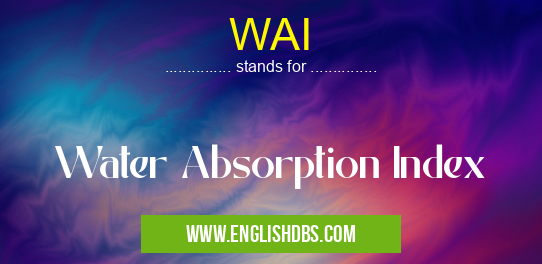What does WAI mean in UNCLASSIFIED
Water Absorption Index (WAI) is a measurement that quantifies the ability of a material to absorb and retain water. It plays a crucial role in various industries, including construction, engineering, and textile manufacturing.

WAI meaning in Unclassified in Miscellaneous
WAI mostly used in an acronym Unclassified in Category Miscellaneous that means Water Absorption Index
Shorthand: WAI,
Full Form: Water Absorption Index
For more information of "Water Absorption Index", see the section below.
Meaning of WAI
WAI is expressed as a percentage and calculated by measuring the weight of a material before and after it has been immersed in water for a specific period. The formula for WAI is:
WAI = [(Weight after immersion - Weight before immersion) / Weight before immersion] x 100%Applications of WAI
-
Construction: WAI is used to assess the water absorption capacity of building materials, such as concrete, bricks, and tiles. High WAI indicates that the material is more susceptible to water damage and may require additional waterproofing measures.
-
Engineering: WAI is used in pavement design to determine the resistance of asphalt and concrete mixtures to water damage. Low WAI values indicate better resistance to water penetration and increased durability.
-
Textile Manufacturing: WAI is used to evaluate the water absorption properties of fabrics. Fabrics with high WAI are more absorbent and suitable for applications such as towels and diapers, while fabrics with low WAI are more water-resistant and ideal for rainwear.
Essential Questions and Answers on Water Absorption Index in "MISCELLANEOUS»UNFILED"
What is the Water Absorption Index (WAI)?
The Water Absorption Index (WAI) is a measure of the amount of water absorbed by a material. It is calculated by measuring the weight of a dry material before and after immersion in water for a specified period. The difference in weight is then divided by the original dry weight to express the water absorption capacity as a percentage.
What is the significance of WAI in materials selection?
WAI is a crucial factor in selecting materials for various applications. For instance, in the construction industry, materials with low WAI are preferred for exterior applications where exposure to water is unavoidable. It helps prevent water damage, such as cracking, swelling, and mold growth.
How is WAI measured?
WAI is measured following specific standards, such as ASTM C150 or ISO 15148. These standards outline the sample preparation, immersion procedure, and calculation methods to ensure consistent and reliable results.
What factors influence WAI?
Several factors can affect the WAI of a material, including porosity, density, and chemical composition. Materials with higher porosity tend to absorb more water, resulting in a higher WAI. Additionally, materials with a lower density are more likely to have a higher WAI.
What applications does WAI have in different industries?
WAI finds applications in various industries, including construction, manufacturing, and pharmaceuticals. In construction, it is used to assess the durability and suitability of building materials. In manufacturing, it helps determine the performance of products that come into contact with water, such as textiles and packaging materials. In pharmaceuticals, WAI is a parameter for characterizing drug delivery systems and ensuring patient safety.
Final Words: WAI is a valuable metric that provides insights into the water absorption capacity of materials. It plays a crucial role in various industries, helping engineers, architects, and manufacturers make informed decisions about material selection and design. Understanding WAI enables the optimization of material performance and the prevention of potential water-related issues.
